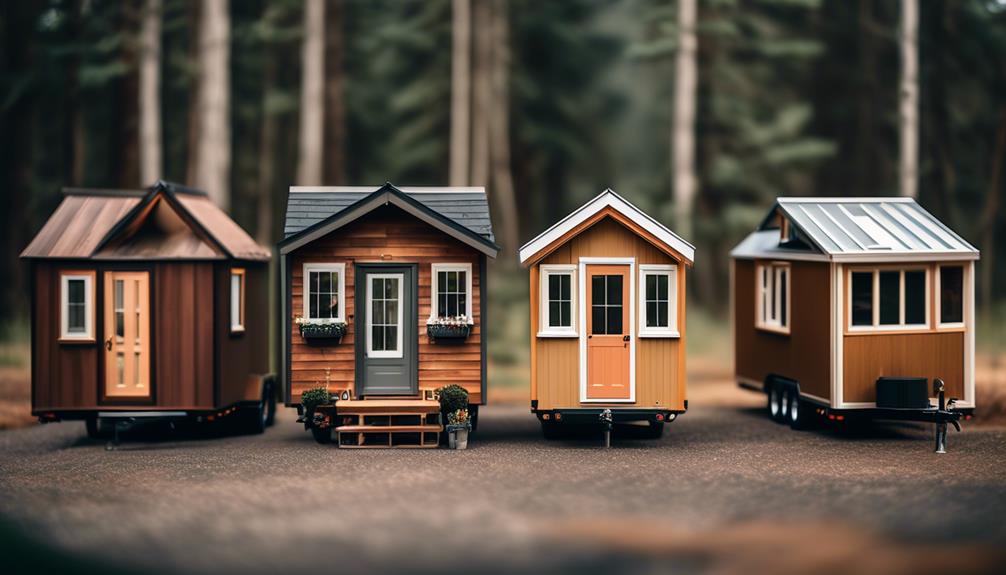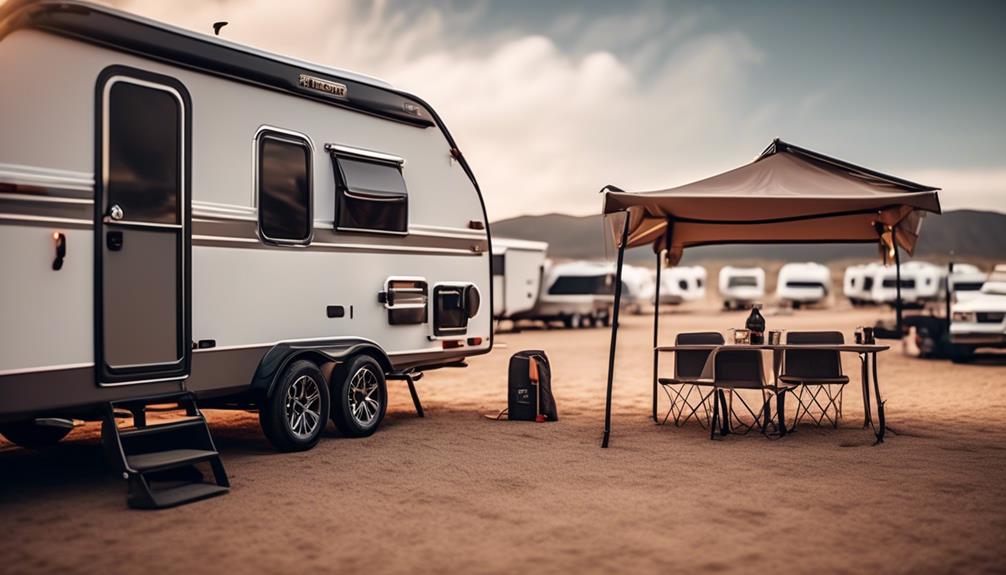Imagine stepping into your tiny house, where every inch of space is carefully designed and utilized to its fullest potential.
Now, picture yourself towing that tiny house on a trailer, navigating through the open road, with the freedom to explore different places and call them home.
But how do you ensure that your tiny house stays within legal limits while maximizing your living space?
In this discussion, we will guide you through the world of trailer sizes and legal restrictions, providing you with the knowledge and insights you need to create your ideal tiny house on wheels.
Get ready to unlock the secrets of maximizing your tiny house while staying within the boundaries of the law.
Key Takeaways
- The height, width, and length of a tiny house on a trailer are regulated by the Department of Transportation (DOT), with a maximum height of 13.5 feet, width of 8.5 feet, and length of 30 feet.
- Towing and legal requirements, including obtaining a Commercial Drivers License (CDL) based on size and weight rules, must be followed to avoid legal issues.
- Different trailer dimensions, such as utility trailers, gooseneck trailers, and deck over trailers, offer different advantages and considerations in terms of living space and towing capabilities.
- Popular trailer sizes for tiny houses include 8.5 feet x 20 feet, 8.5 feet x 24 feet, and 8.5 feet x 30 feet, with special permits required for 10-foot-wide trailers. The interior dimensions of the tiny house are determined by the trailer's deck height, length, and width.
Tiny House Dimensions
Tiny house dimensions play a crucial role in determining the overall size and design of your compact living space. When it comes to creating your dream tiny house, the roof style and loft height are key factors to consider.
The roof style not only adds aesthetic appeal but also affects the headroom in the loft area. Choosing a roof style that maximizes headroom will enhance the livability of your tiny house.
Additionally, the loft height is impacted by the design and overall height of the tiny house. By carefully designing and planning the dimensions of your tiny house, you can create a functional and innovative living space that meets your unique needs and desires.
Towing and Legal Requirements
To ensure a smooth journey and avoid any legal complications, it's essential to understand the towing and legal requirements associated with your tiny house on a trailer. Compliance with regulations, including CDL requirements, is crucial for a hassle-free experience.
Depending on the size and weight of your tiny house, you may be required to obtain a Commercial Drivers License (CDL). CDL classifications, such as Class A, B, and C, are determined by vehicle weight and towing specifications. It's important to familiarize yourself with these classifications and ensure that you meet the necessary requirements.
Trailer Dimensions

As you continue your exploration of tiny house dimensions, let's now shift our focus to the important aspect of trailer dimensions. When it comes to choosing the right trailer for your tiny house, there are several factors to consider. Here are some key points to keep in mind:
- Tiny house trailers come in various sizes, ranging from 60 to 400 square feet.
- Towing regulations dictate the maximum height, width, and length of the trailer.
- Utility trailers are commonly used, while gooseneck trailers allow for longer houses and easier towing.
- Deck over trailers sacrifice vertical height but provide more stability.
- 10-foot-wide trailers require special permits but offer additional living space.
Living Space and Design Considerations
Consider the layout and dimensions of your tiny house to maximize living space and create a functional design.
When it comes to living space and design considerations, two key factors to keep in mind are loft design and roof styles.
The loft design plays a crucial role in maximizing vertical space and creating additional living areas. By carefully planning the loft height and placement, you can optimize headroom in the loft area and create a comfortable sleeping or lounging space.
Additionally, the roof style can greatly impact the overall design and functionality of your tiny house. Different roof styles, such as gable roofs or shed roofs, can offer unique advantages in terms of headroom, natural light, and exterior aesthetics.
Popular Trailer Sizes

When selecting a trailer for your tiny house, it's essential to consider popular trailer sizes that won't only accommodate your living space needs but also comply with legal regulations. Here are some trailer size considerations to keep in mind:
- Deck over trailers: These are commonly used for tiny houses and come in sizes such as 8.5 feet x 20 feet, 8.5 feet x 24 feet, and 8.5 feet x 30 feet.
- Gooseneck trailers: They allow for longer tiny houses and easier towing, with sizes around 8.5 feet wide and a height of around 17 inches.
- Utility trailers: These have a height of around 13 inches and a width of 8.5 feet, making them a popular choice.
- 10-foot-wide trailers: While they require special permits, they offer a wider interior space, with a width of exactly 10 feet.
- Interior dimensions: The size of your tiny house will depend on the deck height, length, and width of the trailer.
Consider these popular trailer sizes to maximize your tiny house's potential while adhering to trailer size restrictions.
Interior Dimensions and Trailer Specifications
To ensure your tiny house meets your desired interior dimensions and complies with trailer specifications, it is crucial to carefully consider the size and design of the trailer you choose. Maximizing interior space while adhering to legal restrictions on trailer size is essential for creating a functional and innovative tiny house. Different trailer dimensions offer varying advantages and limitations. Here is a table outlining the specifications of common trailer types:
| Trailer Type | Height | Width |
|---|---|---|
| Utility | 13" | 8.5 feet |
| Gooseneck | 17" | 8.5 feet |
| Deck Over | 24" | 8.5 feet |
| 10-foot-wide | 13" | 10 feet |
Choosing the right trailer size and type can greatly impact the interior dimensions of your tiny house. Gooseneck trailers, for example, provide more living space due to their extended length over the truck bed. Additionally, considering the roof style and loft height can help maximize headroom and create a comfortable living space. By carefully selecting the trailer that best suits your needs, you can ensure that your tiny house is both legal and optimized for interior design.
Frequently Asked Questions
Can I Exceed the Maximum Height, Width, or Length Limits for a Tiny House on a Trailer?
Yes, you can exceed the maximum height, width, or length limits for a tiny house on a trailer, but it's important to consider the impact on structural integrity and potential legal issues.
What Are the Consequences of Not Complying With the Size and Weight Regulations for Towing a Tiny House?
If you don't comply with size and weight regulations for towing your tiny house, you could face serious consequences. It's important to stay within legal limits to avoid fines, legal issues, and potential damage to your house or trailer.
Are There Any Additional Permits Required for Towing a 10-Foot-Wide Trailer for a Tiny House?
Yes, there are additional costs and building code restrictions for towing a 10-foot-wide trailer for a tiny house. You may need special permits to comply with size regulations and ensure legal compliance.
How Does the Design and Placement of the Roof Affect the Headroom in the Loft Area of a Tiny House?
To maximize loft space in your tiny house design, consider the roof design and placement. A higher roof pitch can provide more headroom in the loft area. Additionally, placing the roof towards the center of the tiny house can create a taller loft space.
Are There Any Specific Considerations for Building Over the Gooseneck Arm on a Gooseneck Trailer for a Tiny House?
When building over the gooseneck arm on a gooseneck trailer for your tiny house, there are a few specific considerations to keep in mind. Follow gooseneck trailer design guidelines to ensure structural integrity and maximize space.
Conclusion
So there you have it, aspiring tiny house dwellers! Now that you know the dimensions and legal requirements of your tiny abode, you can confidently navigate the world of trailer sizes and maximize your living space.
Just remember to tow within the limits and comply with all regulations to avoid any legal headaches.
With a little creativity and knowledge, you'll be living large in your tiny house in no time.
Happy downsizing!

